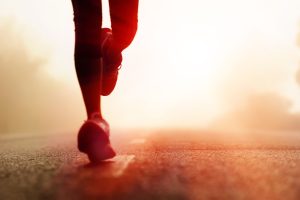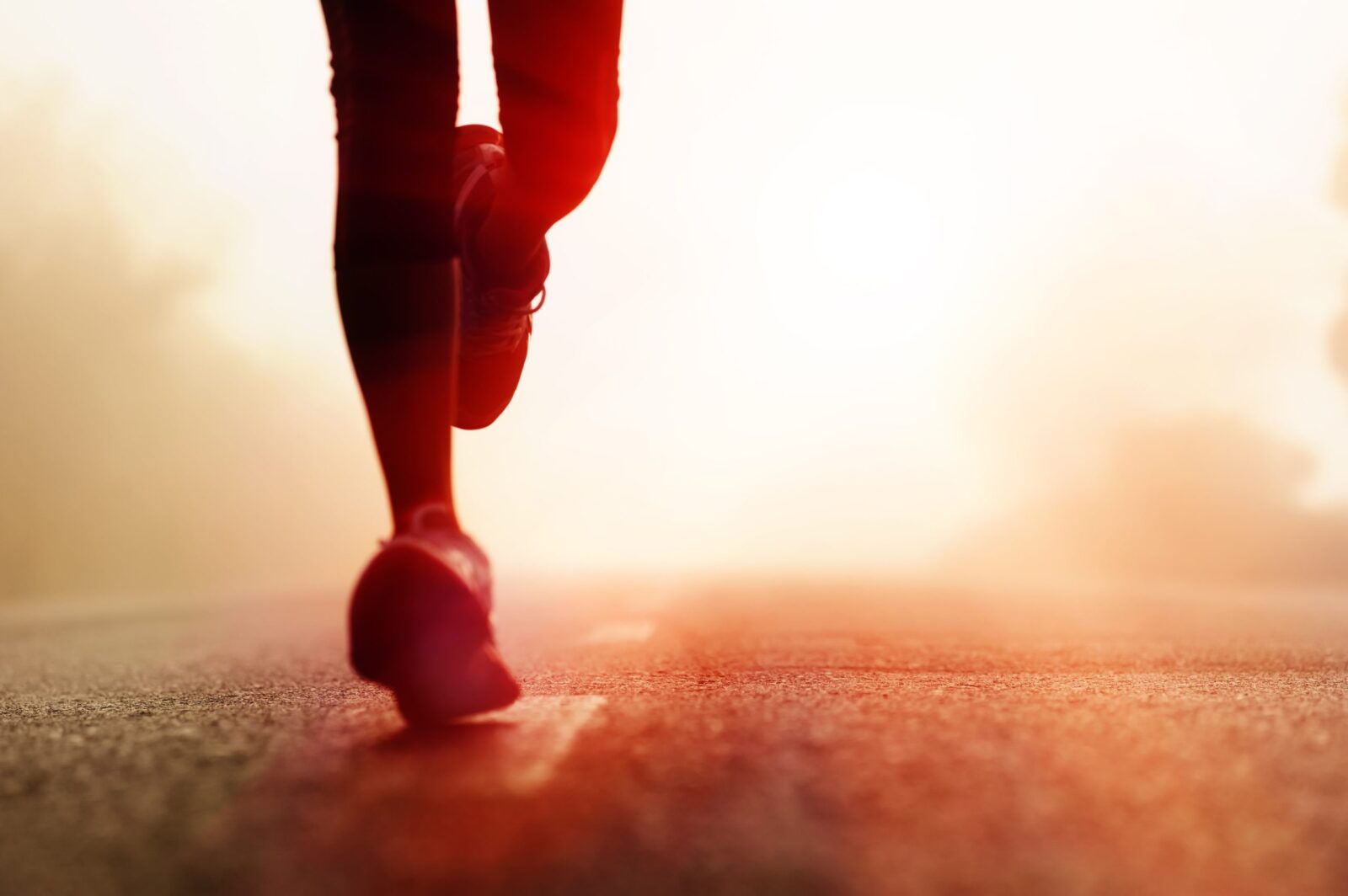“The hip bone’s connected to the knee bone…”

We all remember signing along as a child, but do you really understand the connections between key areas of your body?
The connective component in our body is fascia. This serves to protect, support and encase our entire system from muscles and organs to the nervous system and blood vessels. The importance of fascia is that without it, we would not be able to stand, move or function. Fascia encases every muscle, ligament, tendon. This provides glide between everything, and thick bands of it loop around our body to provide what we refer to as ‘tensegrity’. This means nothing in our body is attached to or rubbing on other structures; it is all literally hung in position by the stretchy but strong fascia which attaches into our bones and skin.
I could talk for ages about the functions of different fascia! But in this article I would like to take a little time to explore some of the common syndromes and conditions experienced by runners and how understanding the pattern of the tension, the tissues involved and how they behave and getting the correct treatment can be simple.
What is ITB Syndrome?
The Iliotibial Band (ITB) is a strong band of fascia that supports the femur from hip to knee and is part of the Spiral band of fascia that loops around our feet and around our upper body.
ITB Syndrome is one of the most common causes for lateral leg and knee pain in runners and athletes. The ITB gets tight during running, or with similar motions, as it rubs against the head of the femur back and forth and the knee flexes and extends causing a stretching and rubbing of the tissue which can become tight and inflamed.
Repeated actions can cause swelling to remain in the knee, or thicker scar tissue to develop around the lateral knee and ITB. The pain may intensify over time or be felt during activity, commonly as the foot strikes the ground if running on a hard surface.
A Tight ITB or ITB syndrome is frequently partnered with Shin Splints, Plantar Fasciitis and/or Piriformis syndrome.
What are Shin Splints?
The ITB fascia is very strong around the knee to provide support to the joint, it then extends along the tibia and inserts into the plantar fascia of the foot. Shin Splints, otherwise known as Medial Tibial Stress Syndromes (MTSS) are a term for most pain felt along the anterior leg adjacent to the shin either anterior or medial (either side of the shin bone).
There are other common causes for pain in this area so it’s important to get the right diagnosis which is why we recommend you visit our Sydney Massage and Physiotherapy practice so we can determine the best treatment for you. Should you press down the shin either side and feel pain in one sharp point you may have a stress fracture (which can occur from prolonged MTSS) or compartment syndrome; both will require R.I.C.E. and further treatment. MTSS affects the whole stretch of the shin from knee to ankle/foot, or at least the lower 2 thirds.
MTSS is common with ITB Syndrome as it too is normally related to tightness and inflammation in the fascia from rubbing against the knee and, in this case the tibia also, during activity. It can be worsened by running on uneven terrain or imbalance in the plantar fascia.
What is Plantar Fasciitis?
The Fascia that supports the movement and bounce of the foot is the Plantar Fascia which you can picture as a triangular structure between the heel, sole and ball of the foot. Plantar Fasciitis sometimes produces symptoms of ‘dropped arches’ or ‘flat feet’ which are clear indicators that the loop of fascia that supports the foot arch is out of balance.
The Plantar fascia of the medial side of the foot attaches to the Fascia of the Tibialis Anterior. And it is often this tension in the Tibial Fascia that will pull someone’s plantar fascia out of line; yet also commonly poor foot wear or an uneven posture will cause the plantar muscles and fascia to have to work hard to stabilize and this can cause imbalance in the rest of the leg in the symptoms discussed in this article, ITB Syndrome, Shin Splints and Piriformis Syndrome.
Plantar Fasciitis can be common with symptoms of shin splints and ITB syndrome as this is all systematic of an imbalance in the spiral fascial line. When treating any of the 4 problems discussed in this article the Plantar Fascia will be assessed.
What is Piriformis Syndrome?
The Piriformis is a small yet volatile muscle in the gluteal system which works to laterally rotate the leg. It attaches the head of the femur to the set of Sacral bones (Sacrum) at the base of the spine.
Piriformis Syndrome is sometimes categorized as Sciatica, a neurological condition effecting the compression of the nerves in the sacral part of the spine. This can cause spasm in the piriformis. However, as it attaches into the femur and is supported by the strong fascia from the ITB, it can be put under strain when coupled with any of the symptoms discussed in this article. This shortening and tightening of the Piriformis can then in turn cause the sciatic nerve to be compressed and neurological discomfort to be present and it is sometimes diagnosed as sciatica.
To treat Piriformis syndrome you must first determine the cause and whether any of the symptoms discussed here are present.
Treatment
If you are experiencing pain in any of the areas discussed here after your work out then R.I.C.E. can often bring relief particularly if yours is symptomatic after a run or activity. Stretching can greatly improve the agility of the fascia and surrounding tissues, static stretching is only recommended when warm (post exercise) so as not to strain or tear the tight tissue fibres.
It is good practice to energize these areas pre run with active movements. Roll your foot across a ball or roller to flex your plantar tissue, rotate your ankle slowly clockwise then counter-clockwise to flex and extend your Tibialis anterior, use your fist to pummel your ITB from knee to hip and across your Piriformis (side of glute) to help open up the fibrous connections between the dermal and deeper fascia. Actively stretch the Piriformis and ITB by lifting your knee across your body, use your hands to feel a good stretch and don’t hold for more than 5 seconds unless you arm warm. Don’t forget to also stretch your quads and calves with some lunges.
An effective treatment for all of these persistent problems, experienced by runners or athletes, on one side of their body or both, is Myo-Fascial Release (MFR). MFR gently stretches and opens up the Fascia and tissues beneath, allowing greater range of movement and less congestion, scar tissues and crossed fibres in the tissues, increased lymphatic and circulatory flow to heal.
In order to provide release, a skilled Massage Therapist or Physiotherapist will need to determine the pattern of the tension to balance the body. Where there is tightness and strength there will normally be slack and weakness in corresponding areas. By assessing your posture and using MFR techniques following known pathways, your therapist can work to resolve movement patterned tension and rotational compensations by drawing flexible fibrous tissues to restricted areas following fascia pathways. Directional pressure can then be used to continue to open deeper into the layers of connective tissues to free deep and chronic restrictive tension. MFR is also often an effective treatment for migraines, IBS, PCOS, breathing difficulties and short muscles.
Self-preventative treatments will include pre exercise heat followed by active stretching warm tissues and home massage with hands, fists or foam rollers or spikey balls. Post exercise ice, elevation and static stretches including stretching of the glutes, quads and hamstrings. Should you be suffering from a chronic problem, or yours is in relation to an injury, then strapping or taping may be advised whilst you are undergoing treatment, and then sometimes as an on-going method to prevent tissue pattern damage caused by old scar tissue.
The aim is to work at keeping the fibers open throughout your body to assure natural motion and health. I would also suggest Pilates to work on balance and posture as, when practiced regularly, this will stretch and strengthen the core and fundamental tissues essential for balance and strength and will put you in touch with the feeling of a straight and healthy you.
If you’re looking for treatment or an expert opinion from one of our physiotherapists, come see us today! You can either BOOK ONLINE or call us on (02)9267 3775. Alternatively, you can take a minute to fill out one of our contact forms and we’ll get in touch with you.

